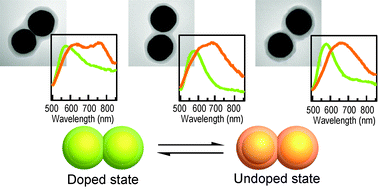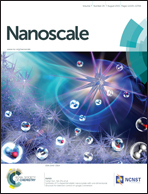Switching plasmon coupling through the formation of dimers from polyaniline-coated gold nanospheres†
Abstract
Active modulation of the plasmon coupling in homodimers of polyaniline (PANI)-coated Au nanospheres is achieved by changing the proton-doping state of the PANI shell. Such a PANI-enabled modulation of the plasmon coupling in the dimers gives rise to remarkable spectral shifts, which show an exponential dependence on the interparticle gap distance. For the dimer with a 10 nm PANI shell thickness and a 0.5 nm gap distance, the shift of the stronger scattering peak in response to the active modulation reaches 231 nm. Electrodynamic simulations reveal that the shift of the dipolar bonding plasmon mode dominates the position variation of the stronger scattering peak for the dimers with different gap distances. Moreover, the quadrupolar bonding plasmon mode can be turned on and off by controlling the proton-doping state of the dimers with gap distances of less than ∼3 nm. These results are of high importance for fundamentally understanding the sensitivity of coupled plasmon resonance modes to the dielectric environment, as well as for designing active plasmonic devices with high modulation performances.


 Please wait while we load your content...
Please wait while we load your content...